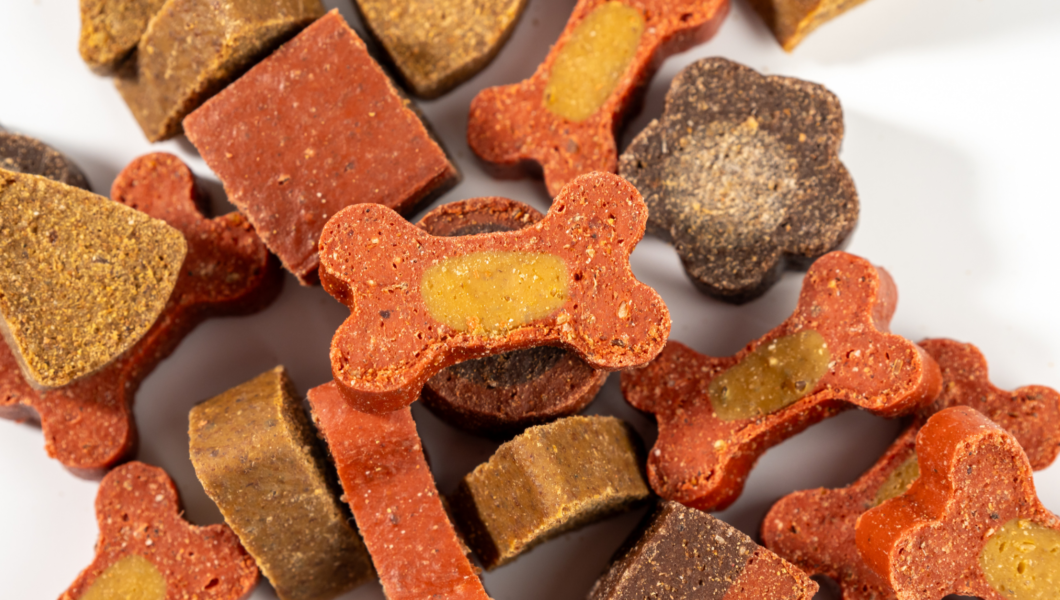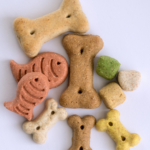The importance of training treats for dogs
As a dog owner, you know that training is an essential part of raising a well-behaved and happy canine companion. One of the most effective tools in the training process is the use of treats. Training treats are not only a powerful motivator for your furry friend, but they also serve as a means of positive reinforcement, helping to strengthen the bond between you and your dog.
Treats are a highly effective way to capture your dog’s attention and keep them engaged during training sessions. By rewarding desired behaviors with a delicious treat, you reinforce those behaviors, making it more likely that your dog will repeat them in the future. This positive reinforcement approach is widely recognized as one of the most humane and effective methods of training.
Moreover, training treats can be used to teach your dog new tricks, commands, and behaviors, making the learning process more enjoyable and rewarding for both you and your pet. Whether you’re working on basic obedience commands or more advanced tricks, the right treats can make all the difference in your dog’s progress and overall training experience.
Read Top 10 Calming Treats for Dogs
What to look for in training treats for dogs
When it comes to choosing the best training treats for your furry friend, there are several important factors to consider. First and foremost, you want to ensure that the treats are not only appetizing to your dog but also safe and nutritious.
One of the key things to look for is the ingredient list. Opt for treats made with high-quality, natural ingredients that are easily digestible and free from artificial preservatives, colors, and flavors. Treats with a high protein content are often a great choice, as they can help keep your dog feeling full and satisfied during training sessions.
Another important consideration is the size and texture of the treats. Ideally, you want treats that are small and easy to break into smaller pieces, allowing you to provide frequent rewards without overfeeding your dog. Soft, chewy treats are often preferred, as they are less likely to cause choking hazards and can be easily consumed during training sessions.
Additionally, it’s important to consider your dog’s individual needs and preferences. If your dog has any dietary restrictions or allergies, be sure to choose treats that are appropriate for their specific requirements. Some dogs may also have preferences for certain flavors or textures, so it may take some experimentation to find the treats that your furry friend loves the most.
Types of training treats for dogs
When it comes to training treats for dogs, there is a wide variety of options available on the market. Here are some of the most popular types:
- Soft Treats: These are typically made from meat or fish and are soft and chewy in texture. Examples include jerky treats, meat-based training treats, and fish-based training treats.
- Crunchy Treats: These are typically made from grains, vegetables, or other plant-based ingredients and have a crispy or crunchy texture. Examples include biscuits, cookies, and dental treats.
- Freeze-Dried Treats: These are made by removing the moisture from meat, fish, or other ingredients through a freeze-drying process. They are lightweight, crunchy, and often have a strong aroma that dogs find irresistible.
- Dehydrated Treats: Similar to freeze-dried treats, these are made by removing moisture from ingredients through a dehydration process. They are typically chewier and have a more concentrated flavor.
- Jerky Treats: Made from strips of meat or fish that have been dehydrated and seasoned, jerky treats are a popular choice for their chewy texture and strong flavor.
- Peanut Butter Treats: These treats are made with peanut butter as a primary ingredient and are often combined with other ingredients like oats or flour. They are soft and have a distinct peanut butter flavor that many dogs love.
- Cheese Treats: Made from various types of cheese, these treats are often soft and have a strong, savory flavor that appeals to many dogs.
Choosing the right size of training treats for dogs
When it comes to training treats, size matters. Choosing the right size of treats is crucial for several reasons:
- Portion Control: Smaller treats allow you to provide frequent rewards during training sessions without overfeeding your dog. This helps maintain a healthy weight and prevents obesity.
- Ease of Consumption: Smaller treats are easier for dogs to consume quickly, which is important during training sessions where you want to keep the momentum going.
- Variety: With smaller treats, you can offer a variety of flavors and textures during a single training session, keeping your dog interested and engaged.
- Age and Breed Considerations: Puppies and smaller breed dogs may have difficulty consuming larger treats, so smaller treats are often a better choice for them.
When selecting the size of training treats, consider your dog’s age, breed, and size. As a general rule, treats should be no larger than the size of your dog’s thumb. For smaller dogs or puppies, even smaller treats may be more appropriate.
It’s also a good idea to break larger treats into smaller pieces or use a treat pouch or bag to keep the treats easily accessible during training sessions. This way, you can quickly reward your dog without interrupting the flow of the training session.
Natural and healthy options for training treats for dogs
While treats are an essential part of the training process, it’s important to choose options that are not only delicious but also nutritious and healthy for your furry friend. Fortunately, there are many natural and healthy options available on the market that can provide the perfect balance of taste and nutrition.
One popular choice is dehydrated or freeze-dried meat treats. These treats are made from high-quality proteins like chicken, beef, or fish, and are often free from additives and preservatives. They are a great source of lean protein and can be easily broken into smaller pieces for training purposes.
Another excellent option is fresh fruits and vegetables. Carrots, sweet potatoes, and apples are all healthy and delicious treats that many dogs enjoy. These natural treats are low in calories and provide valuable nutrients and fiber. However, it’s important to introduce new fruits and vegetables gradually and in moderation to avoid digestive issues.
For dogs with specific dietary needs or allergies, there are also specialized treats available. For example, grain-free treats are a great option for dogs with grain sensitivities, while limited-ingredient treats are ideal for dogs with multiple food allergies.
When choosing natural and healthy training treats, be sure to read the ingredient list carefully and opt for products that are free from artificial preservatives, colors, and flavors. Additionally, consider the calorie content and portion sizes to ensure that you’re not overfeeding your dog during training sessions.
Training treat brands recommended by experts
When it comes to choosing the best training treats for your furry friend, it’s always a good idea to seek recommendations from experts in the field. Here are some of the top training treat brands recommended by professional dog trainers and veterinarians:
Zuke’s
This brand offers a wide range of natural, healthy treats made with high-quality ingredients like real meat, fruits, and vegetables. Their treats are free from artificial preservatives and colors, making them a popular choice among pet owners and professionals alike.
Orijen
Known for their biologically appropriate dog foods, Orijen also offers a line of freeze-dried treats made from high-quality proteins like free-run chicken and wild-caught fish. These treats are nutrient-dense and highly palatable for dogs.
Cloud Star
This brand specializes in all-natural, wholesome treats made with simple, recognizable ingredients. Their Tricky Trainers line is specifically designed for training purposes and comes in a variety of flavors and textures.
Wellness
The Wellness brand offers a range of natural, grain-free treats that are perfect for dogs with sensitivities or allergies. Their WellBites line includes soft and chewy treats made with high-quality proteins and limited ingredients.
Merrick
Known for their high-quality pet foods, Merrick also offers a line of natural, protein-rich treats made with real meat and no artificial preservatives or colors. Their Power Treats line is a popular choice for training purposes.
Blue Buffalo
This brand is committed to using only the highest-quality natural ingredients in their pet products, including their line of training treats. Their Blue Bits and Wilderness Trail Treats are both excellent options for training purposes.
Nutro
Nutro’s line of dog treats includes a variety of natural, wholesome options suitable for training. Their Crunchy Treats and Mini Treats are both highly recommended by experts for their quality ingredients and convenient sizes.
When selecting training treats, it’s always a good idea to consult with your veterinarian or a professional dog trainer to ensure that you’re choosing the best options for your furry friend’s specific needs and preferences.
Homemade training treats for dogs
While there are many excellent commercial training treat options available, some dog owners prefer to make their own homemade treats. Homemade treats offer several advantages, including the ability to control the ingredients, cater to specific dietary needs, and save money in the long run.
One of the simplest and most popular homemade training treats is dehydrated or baked meat. Lean proteins like chicken, turkey, or beef can be sliced thinly, dehydrated or baked until crispy, and then broken into bite-sized pieces. These treats are not only delicious but also high in protein, making them a nutritious reward for your furry friend.
For a softer treat option, you can try making homemade peanut butter treats. Simply mix together peanut butter (make sure it doesn’t contain xylitol, which is toxic to dogs), rolled oats, and a little water or milk. Roll the dough into small balls or cut into bite-sized pieces, and bake until firm but still slightly chewy.
Another tasty and healthy option is homemade sweet potato treats. Slice sweet potatoes into thin rounds, toss with a little olive oil, and bake until crispy. These treats are not only delicious but also packed with vitamins and fiber.
When making homemade treats, it’s important to use high-quality, human-grade ingredients and avoid any ingredients that are toxic to dogs, such as onions, garlic, or raisins. Additionally, be mindful of portion sizes and calorie content to ensure that you’re not overfeeding your furry friend during training sessions.
Training treat dos and don’ts
To ensure that you’re using training treats effectively and safely, it’s important to follow some basic dos and don’ts:
Dos:
- Use high-quality, nutritious treats: Choose treats made with natural, whole-food ingredients and avoid those with artificial preservatives, colors, or flavors.
- Break treats into smaller pieces: Smaller treats allow for more frequent rewards and better portion control.
- Vary the treats: Offer a variety of treats to keep your dog interested and engaged during training sessions.
- Adjust treat sizes based on your dog’s size and activity level: Smaller dogs and less active dogs may require smaller portions to maintain a healthy weight.
- Use treats as a reward, not a bribe: Reward desired behaviors after they occur, rather than using treats to lure your dog into performing a behavior.
Don’ts:
- Don’t overuse treats: While treats are an effective training tool, they should not make up a significant portion of your dog’s daily calorie intake.
- Don’t use treats as a substitute for affection or attention: Treats should be used as a training tool, not as a replacement for quality time and affection with your furry friend.
- Don’t use treats to reward unwanted behaviors: Be selective about when and why you offer treats to avoid reinforcing undesirable behaviors.
- Don’t leave treats within reach of your dog: Treats should be kept out of reach to prevent overeating and maintain their value as a reward.
- Don’t use stale or expired treats: Stale or expired treats may not be as appealing to your dog and could potentially cause digestive issues.
By following these dos and don’ts, you can ensure that you’re using training treats effectively and safely, while also maintaining a healthy and balanced diet for your furry companion.
Training treat storage and handling
Proper storage and handling of training treats are essential to ensure their freshness, safety, and effectiveness during training sessions. Here are some tips to help you keep your dog’s treats in top condition:
- Airtight Containers: Store treats in airtight containers or resealable bags to prevent them from becoming stale or attracting pests. Glass or plastic containers with tight-fitting lids work best.
- Cool, Dry Place: Keep treat containers in a cool, dry place away from direct sunlight and moisture. Exposure to heat and humidity can cause treats to spoil or become stale more quickly.
- Refrigeration or Freezing: For treats with a shorter shelf life, such as fresh or homemade treats, consider storing them in the refrigerator or freezer to extend their shelf life.
- Portion Control: When taking treats out for training sessions, portion out only the amount you’ll need to avoid exposing the remaining treats to air and moisture.
- Clean Hands: Always handle treats with clean hands to prevent the transfer of bacteria or other contaminants.
- Expiration Dates: Check expiration dates on commercial treat packages and discard any expired treats to ensure freshness and safety.
- Treat Pouches or Bags: Invest in a treat pouch or bag designed specifically for training purposes. These pouches often have compartments or closures to keep treats fresh and easily accessible during training sessions.
- Rotation: If you have multiple types of treats, rotate them to ensure that none of them go stale or expire before being used.
By following these storage and handling tips, you can help ensure that your dog’s training treats remain fresh, appealing, and safe to consume, maximizing their effectiveness as a training tool.
Conclusion: Finding the perfect training treats for your furry friend
Choosing the best training treats for your furry friend is an essential part of successful dog training. From the importance of using high-quality, nutritious treats to the various types and sizes available, there are many factors to consider when selecting the perfect treats for your pup.
By following the tips and recommendations outlined in this guide, you’ll be well on your way to finding the ideal training treats that not only motivate and engage your dog but also support their overall health and well-being.
Remember, training treats should be used as a tool for positive reinforcement, not as a substitute for affection or attention. With the right treats and a consistent, patient approach, you can create a rewarding and enjoyable training experience for both you and your furry companion.
If you’re looking for a high-fiber dog food option to complement your training treat regimen, consider exploring Royal Canin’s high-fiber dog food. These specially formulated diets can help support your dog’s digestive health and overall well-being.
Happy training, and may your furry friend be showered with delicious and nutritious treats along the way!


